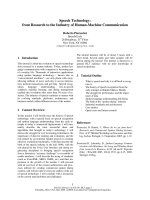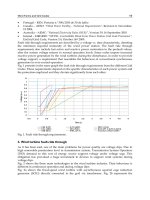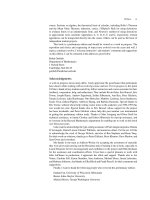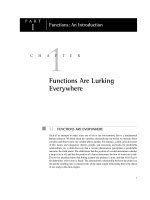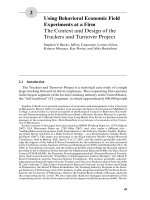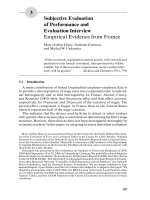From Nuremberg to The Hague - The Future of International Criminal Justice Part 3 ppsx
Bạn đang xem bản rút gọn của tài liệu. Xem và tải ngay bản đầy đủ của tài liệu tại đây (80.42 KB, 21 trang )
government, they will have something to look back
on and be warned in advance … [T]he United States
doesn’t expect anything out of this, and we are
anxious to make a record here that will be a lesson to
the German people.
32
The assumption of Western moral superiority
implicit in the liberal values expressed in the
Indictment was accepted as a necessary underpinning
for the construction of a new moral and political order.
There were also legal problems raised by the trial. The
provision of evidence was far from ideal. Vital material
on the genocide of the Jews only emerged with the
capture of the commandant of Auschwitz, Rudolf Höss,
in March 1946, and his testimony arrived too late to be
included fully in the trial proceedings. The Soviet
Union provided unsworn written depositions about
German atrocities in the east, but refused to allow
Soviet citizens to be called as witnesses at Nuremberg.
In the early summer of 1945, Jackson’s team circulated a
secret memorandum making it clear that it was inexpe-
dient to wait until all the material for trial had been
gathered together, and that the case should rest on ‘the
best evidence readily available’.
33
The whole idea of
The Nuremberg trials: international law in the making 27
32
Imperial War Museum, FO 645, Box 162, interrogation of Fritz
Wiedemann, taken at N
uremberg, 9 October 1945, pp. 22–3.
33
NA II, RG 107, McCloy papers, Box 3, draft Planning
Memorandum, 13 May 1945, pp. 3–5.
conspiracy did prove difficult to demonstrate, and in
the end three of the defendants, von Papen, Schacht and
Fritzsche, were found not-guilty on all four counts.
Subsequent historical research has confirmed that no
such thing as a concerted conspiracy existed, though a
mass of additional evidence on the atrocities of the
regime and the widespread complicity of many offi-
cials, judges and soldiers in these crimes has confirmed
that, despite all the drawbacks of the trial and of its legal
foundation, the conviction that this was a criminal
system was in no sense misplaced.
The Nuremberg trials were an experiment. There was
a clear international consensus among the victor powers
that the perpetrators of aggression should this time be
treated differently by the international community. To
be able to conduct such an experiment it was necessary
to have an agreed set of rules of conduct in international
affairs and on fundamental issues of human rights. The
precise nature of the crimes associated with the war had
to be defined and given clear legal status.What is striking
about the summer of 1945 is not that the trials were in
some sense arbitrary and in defiance of legal convention,
but that so much was achieved in the chaos of post-war
Europe in building the foundation for contemporary
international law on war crimes, and contemporary
conventions on human rights. The International
28
Criminal Court established in 2002 is a direct descen-
dant of the Nuremberg Military Tribunal, as were the
European Convention on Human Rights signed in 1950
and the genocide convention two years earlier.The trials
were without question a political act, agreed at the level
of diplomacy, and motivated by political interests. The
choice of defendants and the definition of the charges
were arbitrary in the extreme, and rested on endless
wrangles between the prosecution teams and govern-
ments of the four Allied states.Yet the final outcome was
less prejudiced and more self-evidently just than these
objections might imply. The trial did not fabricate the
reality of the Third Reich and the death of as many as
seven million men, women and children murdered or
allowed to die by the apparatus of state repression,or the
deaths of many millions more, Germans among them,
from the waging of continental war.After this grotesque
historical experience, few could doubt, either then or
now, that the international community required new
legal instruments to cope with its possible recurrence.
The fact that in many cases since 1945 it has proved
impossible to prevent or anticipate further violations is
not a consequence of the failure of the Nuremberg
experiment,nor of the legal apparatus that it spawned. It
is a consequence of a persistent reality in which power
will always tend to triumph over justice.
The Nuremberg trials: international law in the making 29
30
Issues of complexity, complicity
and complementarity: from the
Nuremberg trials to the dawn of the
new International Criminal Court
Introduction
The International Criminal Court came into existence on
1 July 2002. The new Court has jurisdiction over geno-
cide, crimes against humanity and war crimes; but the
Court can only try international crimes committed on or
after 1 July 2002.Any national,from any of the more than
eighty states that have ratified the Statute of the Court,
can be a potential defendant before the new Court. In
addition, the Court will have jurisdiction over crimes
committed in state parties, even when perpetrated by
nationals from states which have not become parties to
the Statute.There are further grounds for jurisdiction but
we need not dwell on them here. In this contribution I
shall remain with the theme of the Nuremberg trials and
use these trials as a springboard to explore three concepts
which I think may help us to think about the ways in
which the new International Criminal Court will operate.
The three concepts I wish to explore are: complexity,
complicity and complementarity.
Complexity
To understand what I mean by complexity in this
context, let us consider some of the fundamental legal
innovations of the Nuremberg judgment delivered by
the International Military Tribunal. First, the notion of
individuals having concrete duties under international
law, as opposed to national law, was clearly enunciated,
really for the first time, and later accepted by the inter-
national community of states. Until the Nuremberg
trial, war crimes trials had been held at the national
level under national military law. The international
laws of war, such as the Hague Convention of 1907,
already prohibited resort to certain methods of waging
war. But, in the words of the judgment:
the Hague Convention nowhere designates such
practices as criminal, nor is any sentence
prescribed, nor any mention made of a court to try
and punish offenders.
1
Issues of complexity, complicity and complementarity 31
1
Trial of German Major War Criminals (Goering et al.),
International Military Tribunal (Nuremberg), Judgment and
32
The judges, in a remarkable bout of judicial activism,
decided that:
The law of war is to be found not only in treaties,
but in the customs and practices of states which
gradually obtained universal recognition, and from
general principles of justice applied by jurists, and
practised by military courts. This law is not static,
but by continual adaptation follows the needs of a
changing world. Indeed, in many cases treaties do
no more than express and define for more accurate
reference the principles of law already existing.
2
In this way the Tribunal held that, even though the
international treaties they were applying made no
mention of criminal law, the international law of war
created international crimes.
The defence had further argued that international
law did not apply to individuals but only to states. The
Tribunal, in a famous passage, rejected this argument as
well. In the words of the Tribunal:
Many other authorities could be cited, but enough
has been said to show that individuals can be
punished for violations of international law.
Crimes against international law are committed by
Sentence, 30 September and 1 October 1946 (Cmd 6964,
HMSO, London), p. 40; the judgment is also reproduced in
(1947) 41 American Journal of International Law 172–333.
2
Goering et al., note 1 above, p. 40.
Issues of complexity, complicity and complementarity 33
men, not by abstract entities, and only by punishing
individuals who commit such crimes can the
provisions of international law be enforced.
3
It was, in retrospect, a very radical moment in the
history of human rights and humanitarian law. There
was a paradigm shift. It was the beginning of a new way
of thinking about international law as going beyond
obligations on states and attaching duties to individuals
involving criminal responsibility. Human rights law
would later come to create duties for individuals
beyond the types of crimes tried at Nuremberg. More
specifically, human rights law developed around the
prohibitions on genocide, torture, disappearances and
summary executions, so that it is possible to consider
individual responsibility for these human rights viola-
tions, even in the absence of an armed conflict.
These developments may seem now eminently sensi-
ble, even unremarkable, but the situation is complex for
a lawyer,because the same act and the same provision of
international law give rise to multiple responsibilities.
We have,first, the responsibility of the state under inter-
national law for the violation of its international obliga-
tions under a treaty or customary obligation on the laws
of war, and then, secondly, we simultaneously have the
3
Ibid., p. 41.
34
responsibility of the individual for violating the same
law. But the complexity does not end there.
In Nuremberg there was a determination, not only to
try individuals, but, at the same trial, to declare certain
organisations to be criminal organisations. In this way
individuals could later be prosecuted and punished for
past membership of such organisations. Thus the
Tribunal declared criminal the leadership corps of the
Nazi Party, the Gestapo, the SD and the SS.
4
In fact, in drawing up the list of defendants at
Nuremberg, as was explained by Professor Overy in
the first lecture in this series, the Prosecutor selected the
individuals according to their connections to the
organisations which were also targeted in the trial.
The organisations even had their own counsel
appointed by the Tribunal to represent them at the trial.
As was also mentioned by Professor Overy, it was not
only the political organisations which concerned the
prosecutors and judges: there was also a determination
to ensure that German industry, and the industrialists
who had supported the German war effort, were also
exposed and punished. This adds to the complexity
of the proceedings. Not only did international law reach
states, government ministers, individual military
4
The SD is the Sicherheits
deinst des Reichführer SS
, and the SS is
the Schutzstaffen.
Issues of complexity, complicity and complementarity 35
officers, certain political parties and public entities, but
there was also an intention to reach into the private
sector and punish private industrialists and, in a way,
the firms themselves.
One of the original indictees at Nuremberg was the
industrialist from the Krupp company, Gustav Krupp
von Bohlen und Halbach. He was an old man when the
trial started and he was said by his lawyers to be unfit for
trial due to senile dementia. The Tribunal ordered
medical examinations, and, even though he could not
respond to simple commands such as ‘turn your head
from left to right’, the Tribunal refused to drop him
from the indictment. The British Prosecutor strongly
objected to any change or delay, citing ‘the interests of
justice’. On the other hand, the US Prosecutor had been
prepared to substitute Krupp von Bohlen’s son, Alfried,
on the Indictment. This is an odd idea at first sight, but
the documents reveal the extent to which justice was to
be served by prosecuting the Krupp firm, rather than
the individual, even in a situation where the Tribunal
only had jurisdiction over individuals. The US answer
drafted by Robert Jackson stated:
Public interests, which transcend all private
considerations, require that Krupp von Bohlen
shall not be dismissed unless some other
representative of the Krupp armament and
36
munitions industry be substituted. These public
interests are as follows:
Four generations of the Krupp family have
owned and operated the great armament and
munitions plants which have
been the chief source
of Germany’s war supplies. For over 130 years this
family has been the focus, the symbol, and the
beneficiary of the most sinister forces engaged in
menacing the peace of Europe. During the period
between the two World Wars, the management of
these enterprises was chiefly in Defendant Krupp
von Bohlen.
It was at all times, however, a Krupp family
enterprise. Only a nominal owner himself, Von
Bohlen’s wife, Bertha Krupp, owned the bulk of the
stock. About 1937 their son, Alfried Krupp, became
plant manager and was actively associated in the
policy-making and executive management
thereafter …
To drop Krupp von Bohlen from this case
without substitution of Alfried, drops from the case
the entire Krupp family, and defeats any effective
judgment against the German armament makers.
5
The British Prosecutor strongly objected to any
substitution or delay. In the words of the Chief
Prosecutor:
5
Answer of the United States Prosecution to the Motion on
Behalf of Defendant Gustav Krupp von Bohlen, Robert Jackson,
12 November 1945, available at www.yale.edu/lawweb/avalon/
imt/proc/v1-11.htm.
Issues of complexity, complicity and complementarity 37
Although in an ordinary case it is undesirable that a
defendant should be tried when he is unable to
comprehend the charges made against him, or to
give instructions for his defence, there are special
considerations which apply to this case.
6
According to the British Chief Prosecutor, one of the
interests of justice, referred to in the Charter of the
Tribunal in the context of trials in the absence of the
accused,
7
was the public interest in trying the defendant
responsible for the preparation of armaments and
using forced labour from the concentration camps.
The Tribunal’s eventual decision was that Gustav
Krupp could not be tried because of his condition, but
that ‘the charges against him in the Indictment should
be retained for trial thereafter, if the physical and
mental condition of the defendant should permit’.
8
However, his son Alfried was later tried with eleven
others from the Krupp firm by the US Military Tribunal
6
Memorandum of the British Prosecution on the Motion on
Behalf of Defendant Gustav Krupp von Bohlen, 12 November
1945, Sir Hartley Shawcross, available at www.yale.edu/lawweb/
avalon/imt/proc/v1-12.htm.
7
Article 12: ‘The Tribunal shall have the right to take proceedings
against a person charged with crimes set out in Article 6 of this
Charter in his absence, if he has not been found or if the
Tribunal, for any reason, finds it necessary, in the interests of
justice, to conduct the hearing in his absence.’
8
Goering et al., note 1 above, p. 2.
38
in Nuremberg and Alfried received a twelve-year
sentence for plunder and employing prisoners of war
and foreign civilians under inhumane conditions in
connection with the conduct of war.
In Alfried Krupp’s case, the defence lawyers suggested
that international law did not attach to private industri-
alists who did not act on behalf of the state. They sought
to distinguish the Tribunal’s judgment in Goering et al.,
concerning the responsibility of the individual, by
claiming that these individuals had been state agents:
One must consider, however,that, in the case of the
International Military Tribunal, the persons
involved were not private individuals such as those
appearing in this case, but responsible officials of
the State, that is such persons and only such
persons as, by virtue of their office, acted on behalf
of the State. It may be a much healthier point of
view not to adhere in all circumstances to the text of
the provisions of International law, which is, in
itself, abundantly clear, but rather to follow the
spirit of that law,and to state that anyone who acted
on behalf of the state is liable to punishment under
the terms of penal law, because, as an anonymous
subject, the State itself cannot be held responsible
for the compensation of damage. In no
circumstances is it permissible, however, to hold
criminally responsible a private individual, an
industrialist in this case, who has not acted on
behalf of the State, who was not an official or an
Issues of complexity, complicity and complementarity 39
organ of the State, and of whom, furthermore, in
the face of the theory of law as it has been
understood up to this time, and as it is outlined
above, it is impossible to ascertain that he had any
idea, and who, in fact, had no idea that he,
together
with his State, was under an obligation to ensure
adherence to the provisions of international law.
9
The prosecution dealt with this:
It has also been suggested that International Law is
a vague and complicated thing and that private
industrialists should be given the benefit of the plea
of ignorance of the law.Whatever weight, if any,
such a defence might have in other circumstances
and with other defendants, we think it would be
quite preposterous to give it any weight in this case.
We are not dealing here with small businessmen,
unsophisticated in the ways of the world or lacking
in capable legal counsel. Krupp was one of the great
international industrial institutions with numerous
connections in many countries, and constantly
engaged in international commercial intercourse.
10
As stated above, the result for Alfried Krupp was an
eventual sentence of twelve years’ imprisonment.
Although the defence that international law is a
9
Case No. 58, Trial of Alfried Felix Alwyn Krupp von Bohlen und
Halbach and eleven others, US Military Tribunal, Nuremberg, 17
November 1947 to 30 June 1948, Law Reports of Trials of War
Criminals, vol. X, p. 69 at p. 170.
10
Ibid.
40
‘vague and complicated thing’ did not succeed, it is
worth recalling the layers of complexity we have
discussed. First, we have to admit that the crimes prose-
cuted in Nuremberg were not actually formulated as
crimes with the specificity we would expect in a crimi-
nal trial. The Tribunal was, as we saw, inspired by
treaties, the ‘customs and practices of states’ and the
‘general principles of justice applied by jurists and prac-
tised by military courts’.
11
Secondly, this complicated
thing called international law worked, not only to create
obligations for states, but also to create duties for indi-
viduals from public and private life, as well as obliga-
tions for their organisations.
How has this complexity been addressed in the fifty
years since Nuremberg? The Tokyo trial in 1946 dealt
with essentially similar crimes, although the Charter for
that Tribunal was more terse in its listing of crimes.
Article 5 listed the acts which came within the jurisdic-
tion of the Tokyo Tribunal. Article 5(b) is headed
11
The London Charter included the following definition: ‘Article
6(b) WAR CRIMES: namely, violations of the laws or customs of
war. Such violations shall include, but not be limited to, murder,
ill-treatment or deportation to slave labor or for any other
purpose of civilian population of or in occupied territory,
murder or ill-treatment of prisoners of war or persons on the
seas, killing of hostages, plunder of public or private property,
wanton destruction of cities, towns or villages, or devastation
not justified by military necessity.’
‘Conventional War Crimes’, which is then defined as
‘violations of the laws and customs of war’. The simplic-
ity of this definition masks the complexity of the detail
of what actually constitutes a violation of the laws and
customs of war. So, the Charter of the Tokyo Tribunal
offered little assistance in dealing with the first layer of
complexity by failing to specify the actual crimes it was
concerned with. With regard to the second dimension,
there was no development at all. The Tokyo Tribunal
did not deal with issues of criminal organisations or
with the question of the Japanese industrialists, the
zaibatsu.
12
Following the Nuremberg and Tokyo precedents, we
have to wait almost fifty years for further international
criminal trials. In the 1990s, two new international
criminal tribunals were created by the UN Security
Council: first, in 1993, the International Criminal
Tribunal for the former Yugoslavia, and, secondly, in
1994, the International Criminal Tribunal for Rwanda.
These Tribunals developed the scope of international
criminal law even further.By this time we have the extra
Issues of complexity, complicity and complementarity 41
12
For differing views on why the Japanese industrialists w
ere not
included, see A. C. Brackman, The Other Nuremberg: The Untold
Story of the Tokyo War Crimes Trials (Collins, London, 1989), p.
208; and B. V. A. Röling and A. Cassese, The Tokyo Trial and
Beyond: Reflections of a Peacemonger (Polity Press, Cambridge,
1993), p. 39.
specificity of the Genocide Convention of 1948 and of
the 1949 Geneva Conventions and their Protocols of
1977. They in turn developed the scope of genocide as a
crime against humanity and extended international
responsibility into situations of internal armed conflict.
The category of crimes against humanity had first been
introduced into the Nuremberg Charter to ensure that
the deportation of Germans by Germans to the concen-
tration camps and their subsequent mistreatment and
extermination there could be prosecuted. Under the
international laws of war at that time, the way a govern-
ment treated its own nationals was considered by inter-
national law as a matter of domestic jurisdiction rather
than international concern. The introduction of this
new sort of international crime was important.
However, it was introduced in a rather limited way: for
the Nuremberg and Tokyo Tribunals to have jurisdic-
tion over an accused, charges of crimes against human-
ity had to be linked to the armed conflict.
13
It has been
42
13
The Articles concerning crimes against humanity in both
Tribunals specified that the crimes had to be committed ‘in
execution of or in connection with any crime within the juris-
diction of the Tribunal’. The Nuremberg Charter contained an
additional requirement that the acts be committed against ‘any
civilian population’, the Tokyo Charter having been amended to
delete this requirement. Although the Statute of the
International Criminal Court does not require that the crime
against humanity be linked to an armed conflict, the Statute
said by one of the judges from the Tokyo Tribunal that
the requirement that crimes against humanity be linked
to the armed conflict was introduced because some
Americans were, and I quote Judge Röling from the
Tokyo Tribunal, ‘afraid that, without this new element,
the new crime would be applicable to the mistreatment
of Blacks in the US!’
14
Fifty years later, the Yugoslavia and Rwanda
Tribunals have clearly established that crimes against
humanity exist as self-standing crimes. These interna-
tional crimes can be prosecuted even in the absence of
an armed conflict. This new understanding of crimes
against humanity has, in a way, elevated systematic
human rights violations to the level of international
crimes. In fact, the International Law Commission’s
1991 text on Crimes Against the Peace and Security of
Mankind used the expression ‘systematic or mass viola-
tions of human rights’ in the Article which eventually
became Article 18 (‘Crimes against humanity’) of the
Draft Code finally adopted by the ILC in 1996.
Issues of complexity, complicity and complementarity 43
retains the requirement that it be directed against a civilian
population. It is possible that crimes against humanity targeted
at military personnel are crimes under international law,
although it is more likely these would be prosecuted as war
crimes in the context of an armed conflict.
14
B. V. A. Röling and A. Cassese, The Tokyo Trial and Beyond:
Reflections of a Peacemonger (Polity Press,Cambridge,1993), p.55.
In the context of the Rwanda trials, the reach of inter-
national criminal law has been confirmed to apply to
individuals who were not necessarily part of the armed
forces.It is enough to have been the mayor of a village and
to have encouraged rapes simply by one’s presence; it is
enough to be the director of a tea plantation and to allow
trucks to be used to hunt down and exterminate civilians.
In the last situation,a Trial Chamber of the International
Criminal Tribunal for Rwanda in January 2000 found Mr
Musema criminally responsible for such acts. Having
been arrested in 1995 in Switzerland and transferred to
the International Criminal Tribunal for Rwanda in
Tanzania,the Chamber found him guilty of genocide and
crimes against humanity. For these crimes there was no
need for a connection to an armed conflict.He was given
a life sentence. Aggravating circumstances which were
raised at the sentencing stage included the fact that he
took no steps to prevent the participation of the tea
factory employees or the use of its vehicles in the attacks.
898. With respect to the Prosecutor’s argument that
Musema could also be held responsible under
Article 6(3) of the Statute, the Chamber finds, first,
that among the attackers at Rwirambo were persons
identified as employees of the Gisovu Tea Factory.
The Chamber is of the view that their participation
resulted, inevitably,in the commission of acts
referred to under Articles 2 to 4 of the Statute,
44
including, in particular, causing serious bodily and
mental harm to members of the Tutsi group.
899. The Chamber finds that it has also been
established, as held supra, that Musema was the
superior of said employees and that he held not
only de jure power over them, but also de facto
power. Noting that Musema was personally present
at the attack sites, the Chamber is of the opinion
that he knew or, at least, had reason to know that his
subordinates were about to commit such acts or
had done so. The Chamber notes that Musema,
nevertheless, failed to take the necessary and
reasonable measures to prevent the commission of
said acts by his subordinates, but rather abetted in
their commission, by his presence and by his
personal participation.
900. Consequently, the Chamber finds that, for
the acts committed by the employees of the Gisovu
Tea Factory during the attack on Rwirambo Hill,
Musema incurs individual criminal responsibility,
as their superior, on the basis of Article 6(3) of the
Statute.
15
So the complexity of this type of international crimi-
nal law extends past individual states, political parties
and state agents on towards individual private industri-
alists and business people with de facto control over
their subordinates, and finally even towards their firms.
As we saw above, there was a concern in the work of
Issues of complexity, complicity and complementarity 45
15
Alfred Musema Case, ICTR-96-13-T, 27 January 2000.
the Nuremberg Tribunal to ensure the Krupp firm was
addressed as such. In 1946 the Farben company was
actually considered an instrumentality of its directors
in their commission of war crimes and was implicated
in the conviction of the directors by the US Military
Tribunal in Nuremberg. The same Farben company has
much more recently been subject to claims for repara-
tions from the victims of their practices of slave labour.
The German slave labour fund, jointly established by
the state and the firms, currently stands at US$5.2
billion. These claims,together with similar claims made
against the Swiss banks in the Holocaust victims’ assets
litigation (which has resulted in a fund of US$1.25
billion), are based on the law developed during the
Nuremberg trials of the industrialists and its applica-
tion in the US courts. By 1999, more than thirty cases
were brought against US, German and Swiss companies
alleging complicity in Nazi-era crimes, based on the
original trials of the industrialists in Nuremberg. The
latest round of claims concerns Swiss and US banks
with regard to profits from business in South Africa
from 1948 to 1993. The reported demand is for US$50
billion.
16
How does the new International Criminal Court
46
16
‘Banks Sued for Financing S. Africa’s Apartheid Regime’,
Financial Times, 18 June 2002, p. 8.
(ICC) respond to these complexities? First, the new
Court has clarified much of the confusion surrounding
the rather vague nature of the crimes tried in
Nuremberg and Tokyo, and it has included the new
wider jurisdiction for crimes against humanity elimi-
nating any need for a connection to the armed conflict.
For the new Court, crimes against humanity are acts
committed in a widespread or systematic way with an
organisational policy against any civilian population,
where the acts are, among other things, murder,
enslavement, deportation or forcible transfer of popu-
lation, imprisonment in violation of international law,
torture, persecution, enforced disappearance and the
crime of apartheid. All the ICC crimes (with the excep-
tion of aggression, which is still to be defined) are now
listed as individual crimes with the elements of these
crimes listed in a separate document. Rather than the
terse sentence asserting jurisdiction over violations of
the ‘laws and customs of war’, we now have several pages
of war crimes listed in a way which renders them quite
specific. Although some students and defendants may
still complain that this international law is a vague and
complicated thing, it is now at least written down in a
treaty and accessible to everyone.
With regard to the second dimension of complexity,
that is to say the range of actors addressed by the law,
Issues of complexity, complicity and complementarity 47

